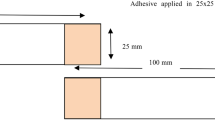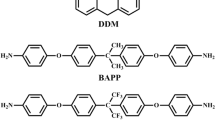Abstract
To evaluate the performance and reliability of a new type of epoxy resin adhesive, the dynamic mechanical analysis (DMA) testing was performed at different levels of temperature and frequency after hydrothermal aging. The results of the DMA and the thermodynamic analysis that the performance of the adhesive has little change after hydrothermal aging for 30 days meant that the resistance to hydrothermal aging of this adhesive was excellent. In addition, the time-temperature equivalence principle and time-aging time equivalence principle were proposed here to offer additional insights into the dynamic mechanical performance of the newly developed adhesive. Moreover, an effective method by which the generalized curve of definite aging time in certain conditions of definite temperature and humidity can be obtained was introduced.

Graphical abstract












Similar content being viewed by others
References
Alessi S, Conduruta D, Pitarresi G, Dispenza C, Spadaro G (2011) Accelerated ageing due to moisture absorption of thermally cured epoxy resin/polyethersulphone blends. Thermal, mechanical and morphological behaviour. Polym Degrad Stab 96:642–648
Bai Y, Keller T (2011) Effects of thermal loading history on structural adhesive modulus across glass transition. Constr Build Mater 25:2162–2168
Banea MD, Sousa FSM, Silva LFM et al (2011) Effects of temperature and loading rate on the mechanical properties of a high temperature epoxy adhesive. Journal of Adhesion Science & Technology 25:2461–2474
Benzarti K, Chataigner S, Quiertant M, Marty C, Aubagnac C (2011) Accelerated ageing behaviour of the adhesive bond between concrete specimens and CFRP overlays. Constr Build Mater 25:523–538
Butt RI, Cotter JL (1976) The effect of high humidity on the dynamic mechanical properties and thermal transitions of an epoxy-polyamide adhesive. J Adhes 8:11–19
Campana C, Leger R, Sonnier R et al (2017) Effect of post curing temperature on mechanical properties of a flax fiber reinforced epoxy composite. Composites Part A: Applied Science & Manufacturing 107:171–179
Carbas RJC, Silva LFM, Marques EAS et al (2014) Effect of cure temperature on the glass transition temperature and mechanical properties of epoxy adhesives. J Adhes 90:104–119
Carlberger T, Biel A, Stigh U (2009) Influence of temperature and strain rate on cohesive properties of a structural epoxy adhesive. Int J Fract 155:155–166
Chang SH, Kim HS (2011) Investigation of hygroscopic properties in electronic packagings using molecular dynamics simulation. Polymer 52:3437–3442
Christoph C, Martinelli E, Michels J et al (2012) Effect of curing conditions on strength development in an epoxy resin for structural strengthening. Compos Part B 43:398–410
Colombini D, Martinez-Vega JJ, Merle G (2002) Influence of hydrothermal ageing and thermal treatments on the viscoelastic behavior of DGEBA-MCDEA epoxy resin. Polym Bull 48:75–82
Cormier L, Joncas S (2017) Modelling the storage modulus, transition temperatures and time–temperature superposition characteristics of epoxies and their composites. Journal of Thermal Analysis & Calorimetry 1:1–13
Fan HJ, Wang J, Zhang H (2017) Applications of dynamic mechanical thermal analysis in polymers and composite materials. Chemistry and Adhesion 39:132–134
Fernandez-Garcia M, Chiang MYM (2002) Effect of hygrothermal aging history on sorption process, swelling, and glass transition temperature in a particle-filled epoxy-based adhesive. J Appl Polym Sci 84:1581–1591
Ferrier E, Rabinovitch O, Michel L (2016) Mechanical behavior of concrete–resin/adhesive–FRP structural assemblies under low and high temperatures. Constr Build Mater 127:1017–1028
Fitriah SN, Majid MSA, Ridzuan MJM et al (2017) Influence of hydrothermal ageing on the compressive behaviour of glass fibre/epoxy composite pipes. Compos Struct 159:350–360
Fraga AN, Alvarez VA, Vazquez A, de la Osa O (2003) Relationship between dynamic mechanical properties and water absorption of unsaturated polyester and vinyl ester glass fiber composites. J Compos Mater 37:1553–1574
Frigione M, Aiello MA, Naddeo C (2006a) Water effects on the bond strength of concrete/concrete adhesive joints. Construction & Building Materials 20:957–970
Frigione M, Lettieri M, Mecchi AM (2006b) Environmental effects on epoxy adhesives employed for restoration of historical buildings. J Mater Civ Eng 18:715–722
Goertzen WK, Kessler MR (2007) Dynamic mechanical analysis of carbon/epoxy composites for structural pipeline repair. Compos Part B 38:1–9
Herzog B, Gardner DJ, Lopez-Anido R, Goodell B (2005) Glass-transition temperature based on dynamic mechanical thermal analysis techniques as an indicator of the adhesive performance of vinyl ester resin. J Appl Polym Sci 97:2221–2229
Ivanova KI, Pethric RA, Affrossman S (2000) Investigation of hydrothermal ageing of a filled rubber toughened epoxy resin using dynamic mechanical thermal analysis and dielectric spectroscopy. Polymer 41:6787–6796
Ivanova KI, Pethrick RA, Affrossman S (2001) Hygrothermal aging of rubber-modified and mineral-filled dicyandiamide-cured DGEBA epoxy resin. II. Dynamic mechanical thermal analysis. J Appl Polym Sci 82:3477–3485
Karbhari VM, Wang Q (2004) Multi-frequency dynamic mechanical thermal analysis of moisture uptake in E-glass/vinylester composites. Compos Part B 35:299–304
Kotyniaa R, Adamczewskaa K, Strakowskab A et al (2017) Effect of accelerated curing conditions on shear strength and glass transition temperature of epoxy adhesives. Procedia Engineering 193:423–430
Kregl L, Wallner GM, Lang RW, Mayrhofer G (2017) Effect of resin modifiers on the structural properties of epoxy resins. J Appl Polym Sci 134:45348
Lettieri M, Frigione M (2012) Effects of humid environment on thermal and mechanical properties of a cold-curing structural epoxy adhesive. Constr Build Mater 30:753–760
Liu L, Song L, Li J (2012) Effects of accelerated aging period of time at 180°C on tensile strength of 3-dimension-4-direction braided/epoxy resin composites. Adv Mater Res 382:312–315
Maiti A (2016) A geometry-based approach to determining time-temperature superposition shifts in aging experiments. Rheol Acta 55:83–90
Maljaee H, Ghiassi B, Lourenco PB (2017) Effect of synergistic environmental conditions on thermal properties of a cold curing epoxy resin. Compos Part B 113:152–163
Michels J, Cruz JS, Christen R et al (2016) Mechanical performance of cold-curing epoxy adhesives after different mixing and curing procedures. Compos Part B 98:434–443
Michels J, Widmann R, Czaderski C, Allahvirdizadeh R, Motavalli M (2015) Glass transition evaluation of commercially available epoxy resins used for civil engineering applications. Compos Part B 77:484–493
Moosburger-Will J, Greisel M, Horn S et al (2015) Physical aging of partially crosslinked RTM6 epoxy resin. J Appl Polym Sci 131:205–212
Moussa O, Vassilopoulos AP, Castro J et al (2012) Time–temperature dependence of thermomechanical recovery of cold-curing structural adhesives. International Journal of Adhesion & Adhesives 35:94–101
Moussa O, Vassilopoulos AP, Castro J et al (2013) Long-term development of thermophysical and mechanical properties of cold-curing structural adhesives due to post-curing. J Appl Polym Sci 127:2490–2496
Odegard GM, Bandyopadhyay A (2011) Physical aging of epoxy polymers and their composites. J Polym Sci B Polym Phys 49:1695–1716
Oregui M, de Man A, Woldekidan MF et al (2016) Obtaining railpad properties via dynamic mechanical analysis. J Sound Vib 363:460–472
Prolongoa SG, Rosariob GD, Uren A (2006) Comparative study on the adhesive properties of different epoxy resins. International Journal of Adhesion & Adhesives 26:125–132
Savvilotidou M, Vassilopoulos AP, Frigione M, Keller T (2017a) Effects of aging in dry environment on physical and mechanical properties of a cold-curing structural epoxy adhesive for bridge construction. Constr Build Mater 140:552–561
Savvilotidou M, Vassilopoulos AP, Frigione M, Keller T (2017b) Development of physical and mechanical properties of a cold-curing structural adhesive in a wet bridge environment. Constr Build Mater 144:115–124
Sawpan MA, Holdsworth PG, Renshaw P (2012) Glass transitions of hygrothermal aged pultruded glass fibre reinforced polymer rebar by dynamic mechanical thermal analysis. Mater Des 42:272–278
Silva P, Fernandes P, Sena-Cruz J, Xavier J, Castro F, Soares D, Carneiro V (2016) Effects of different environmental conditions on the mechanical characteristics of a structural epoxy. Compos Part B 88:55–63
Song L, Li J (2012) Effects of heat accelerated aging on tensile of three dimensional braided/epoxy resin composites strength. Polym Compos 33:1635–1643
Tazi M, Erchiqui F, Godard F et al (2014) Characterization of rheological and thermophysical properties of HDPE-wood composites. J Appl Polym Sci 131:205–212
Vietri U, Guadagno L, Raimondo M, Vertuccio L, Lafdi K (2014) Nanofilled epoxy adhesive for structural aeronautic materials. Compos Part B 61:73–83
Wang Z, Xian G, Zhao XL (2018) Effects of hydrothermal aging on carbon fibre/epoxy composites with different interfacial bonding strength. Constr Build Mater 161:634–648
Xu CY, Xing C, Pan H, Kamdem PD, Matuana LM, Jian W, Wang G (2016) Time-temperature superposition principle application to the hygrothermal discoloration of colored high-density polypropylene/wood composites. Polym Compos 37:1016–1020
Yang Q, Chen X, Lan FT et al (2016) Effects of curing degree on the hydrothermal aging properties of epoxy resins. Thermosetting Resin 31:42–46
Yue YJ, Chen F, Liu Y, Jing YQ (2013) Research on the influence of epoxy resin from hydrothermal aging. Appl Mech Mater 331:403–406
Zhang M, Sun B, Gu B (2016) Accelerated thermal ageing of epoxy resin and 3-D carbon fiber/epoxy braided composites. Composites Part A: Applied Science & Manufacturing 85:163–171
Acknowledgements
This work was supported by the Project of Hunan Provincial Science & Technology Department of PR China (No. 2010GK3110), the Key Project of the Education Department of Hunan Province of PR China (No. 10A130), and the Innovation Project of Postgraduate of Central South University of Forestry & Technology of PR China (No. 20181008).
Author information
Authors and Affiliations
Corresponding author
Additional information
Publisher’s note
Springer Nature remains neutral with regard to jurisdictional claims in published maps and institutional affiliations.
Highlights
• A new type of room temperature-cured epoxy adhesive was fabricated.
• The hydrothermal aging and dynamical mechanical properties of epoxy adhesive were experimentally investigated.
• Theoretical models that can predict material properties in definite condition were developed.
• The findings reported in this work pave the ways to apply the adhesive in engineering structures subjected to extreme environmental conditions.
Rights and permissions
About this article
Cite this article
Li, H., Luo, Y., Hu, D. et al. Effect of hydrothermal aging on the dynamic mechanical performance of the room temperature-cured epoxy adhesive. Rheol Acta 58, 9–19 (2019). https://doi.org/10.1007/s00397-018-1121-9
Received:
Revised:
Accepted:
Published:
Issue Date:
DOI: https://doi.org/10.1007/s00397-018-1121-9




